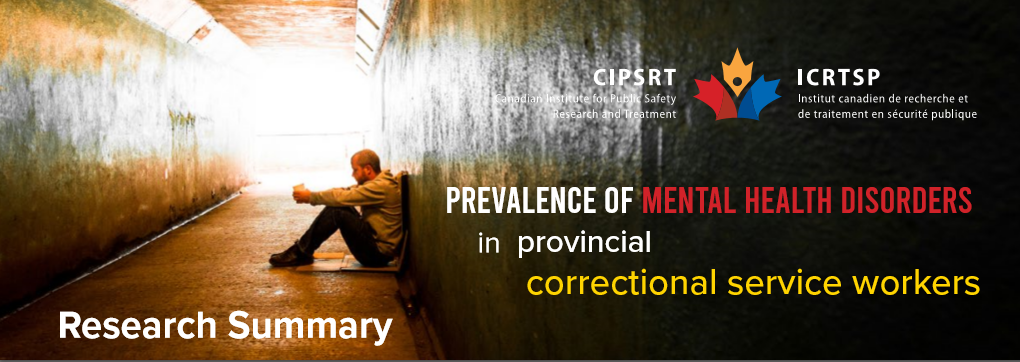Research Summaries
Why was the study done?
Correctional workers, like all public safety personnel (PSP), are exposed to potentially psychologically traumatic events (PPTEs). However, very little research has been done on the prevalence of mental health disorders among correctional workers employed in institutions or the community. The current study had three purposes:
1. To explore self-report rates (i.e. participants’ own reports of their symptoms) for mental health disorders in Ontario correctional workers
2. To look at the differences in mental health disorders for various correctional job categories.
3. To investigate relationships between mental health disorders and demographic risk factors like sex, age, and marital status.
What was done in the study?
A request to participate in the web-based survey was sent to Ontario correctional workers through the Solicitor General of Ontario and the Public Service Employees Union. The survey included previously used screening measures for Posttraumatic Stress Disorder (PTSD), Major Depressive Disorder (MDD), Generalized Anxiety Disorder (GAD), Panic Disorder (PD), and Alcohol Use Disorder (AUD), in addition to sociodemographic questions and questions about job category.
Participants were asked to identify their job category from a list of six categories. The categories were: correctional officers, probation officers, wellness (nurses, social workers), training (teachers, chaplains, etc.), governance (superintendents, etc.), and administration.
What did we find out?
- Positive screens for all mental health disorders increased with age. There was a significant difference between those in the 20–29 year old group and the 40–49 year old group, with the 40-49 year old group having a higher number of positive screens.
- Generally, the longer someone was on the job, the more likely they were to screen positive for a mental health disorder. A significant difference exists between those with less than four years of correctional work experience compared to those with more than 15 years of correctional work experience.
- Married participants or those in common-law relationships screened positive less often for mental health disorders in comparison to participants who were separated, divorced, or widowed.
- Workers in the wellness category were less likely to screen positive for mental health disorders than other categories, especially training, governance, and probation officers.
- Prevalence rates for the different mental health disorders varied by job category, but in the total sample, they were as follows: 30.7 % PTSD, 37% MDD, 30.5% GAD, 14.1% PD, 6.7% AUD.
- Correctional officers were most likely to screen positive for mental health disorders
- There was no overall difference between men and women participants except for those in the correctional officer category, where women were more likely to screen positive for mental health disorders.
- The results were comparable to studies of federal correctional officers, but the provincial correctional officers had higher rates of positive screens for MDD and GAD.
Where do we go from here?
The results of the current study support those found in the federal correctional population. While there are many limitations to web-based surveys, the results show a need for increased mental health supports for correctional workers. Studies are currently being undertaken, but more are required, to help understand the mental health needs faced by correctional workers
The original wording of the study was changed and condensed for the current lay summary
For more information about this research contact: CIPSRT@cipsrt-icrtsp.ca
Original Study: Carleton, R.N., Ricciardelli, R., Taillieu, T., Mitchell, M.M., Andres, E., & Afifi, T. 2020. Provincial correctional service workers: The prevalence of mental disorders. International Journal of Environmental Research and Public Health, 17(7), 2203. https://doi.org/10.3390/ijerph17072203
Summary prepared by Kossick, E. Reviewed & edited by : Barootes, B. & Ricciardelli, R. June 2020.
